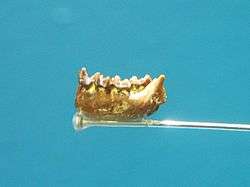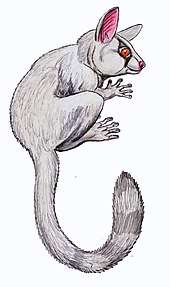Teilhardina
| Teilhardina[1][2] | |
|---|---|
 | |
| Teilhardina belgica | |
| Scientific classification | |
| Kingdom: | Animalia |
| Phylum: | Chordata |
| Class: | Mammalia |
| Order: | Primates |
| Suborder: | Haplorrhini |
| Family: | †Omomyidae |
| Genus: | †Teilhardina Simpson, 1940 |
| Species | |
| |
Teilhardina was an early marmoset-like primate that lived in Europe, North America and Asia during in the Early Eocene epoch, about 56-47 million years ago.[1][3] The paleontologist George Gaylord Simpson is credited with naming it after the French paleontologist, Jesuit and philosopher Teilhard de Chardin. It is known from quite a few species:

The carbon isotope excursion suggests that the Asian Teilhardina asiatica is the oldest; the youngest are the North American Teilhardina americana and Teilhardina brandti.[4]
There are four hypotheses that have been proposes to try and explain the geographic distribution:[4]
1. Africa was the origination of the primates and then they dispersed to Europe- Greenland and finally North America.
2. Primates originated in North America then dispersed to Asia through the Bering route and later passed through Greenland to finally reach Europe.
3. Primates originated in Asia or Africa and dispersed through North America and finally reaching western Europe.
4. Asia was the primate’s origination, they then dispersed eastward towards North America and westward to Europe.
At one point a hypothesis arose that the primates may have originated in India prior to Asia plate collision near the Paleocene Eocene boundary and they spread into Asia after it collided.[4]
These hypotheses were re-evaluated using new morphological evidence and earliest records of Teilhardina species involved from the continents (e.g. Asia, Europe, Africa etc.). The researchers concluded that none of the hypotheses fit the pattern that had emerged from their studies.[4]
A new hypothesis arose from the research; it is now believed that at the beginning of the Paleocene–Eocene Thermal Maximum the Teilhardina dispersed from east to west near the Northern Hemisphere. The earliest primates migrated via crossing the Turgai Straits from South Asia to Europe, finally dispersing to North America through Greenland. In simplest terms, it is as follows: westward Asia-to-Europe-to-North America.[4]
The placement of this genus is uncertain and it is likely to be polyphyletic.[5] Two species (T. belgica and T. asiatica) appear to be the basalmost haplorrhines. The others appear to be anaptomorphine omomyids (and thus more closely related to the tarsiers than to simians) and should have a new genus erected. For instance, T. crassidens has been referred to the genus Baataromomys.[6][7]
References
- 1 2 Beard, K.C. (2008). "The oldest North American primate and mammalian biogeography during the Paleocene-Eocene Thermal Maximum" (PDF). Proceedings of the National Academy of Sciences. 105 (10): 3815–8. doi:10.1073/pnas.0710180105. PMC 2268774. PMID 18316721. Archived from the original (PDF) on 2009-01-31.
- ↑ Tornow, M.A. (2008). "Systematic analysis of the Eocene primate family Omomyidae using gnathic and postcranial data". Bulletin of the Peabody Museum of Natural History. 49 (1): 43–129. doi:10.3374/0079-032X(2008)49[43:SAOTEP]2.0.CO;2.
- ↑ Smith, T.; Rose, K.D.; Gingerich, P.D. (2006). "Rapid Asia-Europe-North America geographic dispersal of earliest Eocene primate Teilhardina during the Paleocene-Eocene Thermal Maximum". Proceedings of the National Academy of Sciences. 103 (30): 11223–7. doi:10.1073/pnas.0511296103. PMC 1544069. PMID 16847264.
- 1 2 3 4 5 Smith, Thierry; Rose, Kenneth D.; Gingerich, Philip D. (2006-07-25). "Rapid Asia–Europe–North America geographic dispersal of earliest Eocene primate Teilhardina during the Paleocene–Eocene Thermal Maximum". Proceedings of the National Academy of Sciences of the United States of America. 103 (30): 11223–11227. doi:10.1073/pnas.0511296103. ISSN 0027-8424. PMC 1544069. PMID 16847264.
- ↑ Primates
- ↑ Ni, X., Wang, Y., Hu, Y. & Li, C., 2004: A euprimate skull from the early Eocene of China. Nature: Vol. 427, #1, pp. 65-68
- ↑ X. Ni, K. C. Beard, J. Meng, Y. Wang, and D. L. Gebo. 2007. Discovery of the first early Cenozoic euprimate (Mammalia) from Inner Mongolia. American Museum Novitates 3571:1-11.